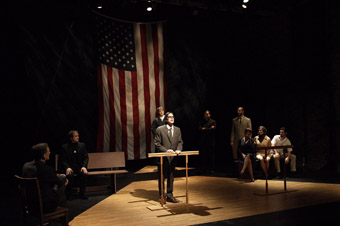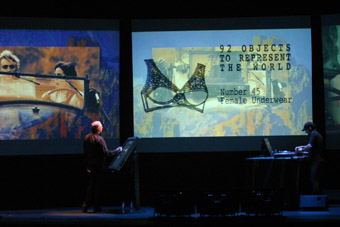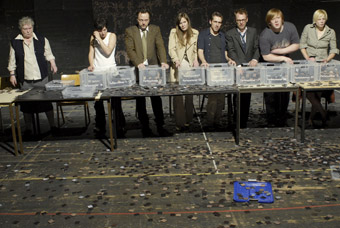 |
The Trial of the Catonsville Nine, The Actors’ Gang photo Kim Zsebe |
miracle in brisbane
A work central to Terracini’s 2009 Brisbane Festival program is Miracle in Brisbane, directed by Rhoda Roberts and featuring 25 Aboriginal, Torres Strait Islander and other artists, including Aaron Fa’Aoso, Deborah Mailman, Djakapurra Munyarrayan and Casey Donovan. The work, a largely wordless opera, “with music, dance and ceremony”, by Italian composer Giorgio Battistelli (of Experimentum Mundi fame), concerns homeless Indigenous people building a shantytown “on country” in Brisbane’s outskirts and at odds with developers. As you’d expect of Battistelli, the music of Miracle in Brisbane will in part come from the sounds of the performers constructing the shantytown to the accompaniment of The Queensland Orchestra and the Canticum Chamber Choir. Battistelli describes the opera as a “‘voiceless’ protest against inhumanity [that] highlights the incontrovertible rights of marginalised people to stake a claim in a world that ignores them.” His theme is hope.
Rhoda Roberts explained to me that Aboriginal people have long had a connection to the land on which Brisbane is built, and yet when they live on or visit it they’re seen as fringe dwellers or homeless— “We’re not, that land is our home.” When she visited Giorgio Battistelli in Milano she sensed a similar relationship between locals and the land and a “sense of purpose” that went with it. She saw the Milano performance of Miracle with its huge cast and was “struck by the expressiveness of the work, the way the music was embodied.” Roberts says that staging an opera will be a first time experience, for her and most of her talented cast, but clearly she looks forward to the creative opportunities it offers.
Battistelli’s open-ended approach to his opera has allowed Roberts to construct a local narrative for the work, a romance between an Italian cane-cutter immigrant (another marginalised figure, played here by a visiting Italian tenor) and an Aboriginal woman. The story unfolds against the construction of the shantytown with the “music of found objects and body percussion”, the voices of developers and the enforced silence of Aboriginal people.
On the festival’s ideas front, the hope theme is sustained in the person of this year’s guest Mary Robinson, former President of Ireland (1990-97) and United Nations High Commissioner for Human Rights (1997-2002). Her talk is titled: “Creating a World without Poverty: Social Business and the Future of Capitalism.” The hope inherent in fighting for one’s beliefs is portrayed in the Los Angeles-based Actors’ Gang performance of The Trial of the Catonsville Nine. It’s about the prosecution and trial of Catholic priests and activists in 1968 who burned draft cards with napalm in protest against the Vietnam War.
new circus
Innovative new circus in the program is represented by two works. Regarding the Joy of Others, is a premiere from Brisbane’s globe-trotting CIRCA, performed on the giant Brisbane gasometer at Newstead Riverpark by aerialist Chelsea McGuffin to a sound score by Lawrence English and direction by Yaron Lifschitz. L’Oratorio d’Aurélia, from French company L’Oratorio is a fantasy inspired by images from the Middle Ages with actress and acrobat Aurélia Thierrée: “Body parts disengage and even disappear, only to be knitted back together again, puppets attack their masters, while clothes, furniture and clattering toy trains come alive.”
 |
Peter Greenaway, Tulse Luper Suitcases |
peter greenaway
With DJ Radar (Serge Dodwell) and electro-acoustical composer Huibert Boon, Peter Greenaway presents his major and much-travelled, large plasma touch screen work, Tulse Luper Suitcases. It’s a technical and aesthetic creation that allows the artists to VJ “the life of the Welsh writer and perennial prisoner Tulse Luper who archived his entire life in 92 suitcases.” There’ll also be a retrospective of Greenaway’s films and he’ll deliver a lecture on his documentary, Rembrandt’s J’Accuse.
total nowhere emotion expansion
In a 2009 festival innovation audiences will be able to view a media art exhibition, Total Nowhere Emotion Expansion, either online via the festival website or live at a mobile media art gallery, once a semi-trailer, travelling within Brisbane and South East Queensland locations. The eight international artists include Australians Darren Sylvester and Jemima Wyman (whose eerie video works featured recently at KickArts Gallery in Cairns) and the Philadelphia-based Ryan Trecartin, maker of a much praised feature-length video work I-Be Area, described by the New Museum, New York, as narratives that “ricochet between characters and actions, gleaning information and enacting existential dramas at hyper-speed. His characters, all constructed collaboratively with his actors, include independent avatars, people composites, culture collectors, and cyber queers—all twisted and true emblems of what the artist calls ‘a potential part-cyber today’” (www.newmuseum.org).
The full Under the Radar fringe program will be announced this month, but advance notice includes Sunny Drake’s Other-wise, Robert Millet’s Vodka & Truth, and Genevieve Trace’s misuse of a comma. Drake’s experiences as a queer/transgender individual, a traveller, a romantic, a teacher and a performer are central to his solo performance in a festival that argues for freedom, often from unexpected angles.
 |
Pornography, Deutsches Schauspielhaus Hamburg photo AT Schaefer |
melbourne international arts festival 2009
Brett Sheehy’s first Melbourne Festival is strong on visiting contemporary performance, theatre and dance if low on Australian content relative to the Robyn Archer and Kristy Edmunds years. Berlin-based Sasha Waltz and Guests in their long-awaited first Australian visit will perform two works: the celebrated Körper (RT90, p10) and a dance-opera Medea with one singer, coloratura soprano Caroline Stein, text by Heiner Muller, music by Pascal Dusapin played by the Melbourne Symphony Orchestra and Vocalconsort Berlin, 17 dancers and video by Waltz. Deutsches Schauspielhaus Hamburg’s production of British playwright Simon Stephen’s Pornography comprises seven narratives about Britain under attack from both terrorism and “the pornography of the everyday.” Belgian company Le Salon’s much anticipated Peeping Tom fuses theatre, dance and song (from mezzo-soprano Eurudike De Beul). Like Stephens’ Pornography it portrays a culture in decline, here exemplified by a family falling apart and revealed in images alternatively melancholic, savage and surreal.
‘Surreal’ is always apt for most things written by Lally Katz. In Apocalypse Bear Trilogy (directed by two of its performers, Luke Mullins and Brian Lipson) for Stuck Pigs Squealing, the internet has absorbed all memory and conjured up a seemingly amiable bear to help you out in any difficult circumstance. Perhaps the bear is a metaphor for the net—wilder than we think or an accident just waiting to happen. Another lateral look at the everyday is stage designer and installation artist Anna Tregloan’s The Dictionary of Imaginary Places, for Store Room Theatre with sound composer and designer David Franzke. Tregloan and Franzke’s work together on the Bell Shakespeare Venus and Adonis and Ranter’s Holiday is evidence of a potent creative partnership. For the new work, the pair rode trains, recorded conversations and “shaped and edited them into poetically built theatre which complements them with startling visuals and extended physicality.” Real life gets another look-in in Vanessa Van Durme’s Look Mummy I’m Dancing, a frank personal account of gender change in 1970s Belgium.
Peter Greenaway will present his 20-minute multimedia installation Leonardo’s Last Supper replete with large screens, soundscape and a reconstruction of the table, from the painting, where Christ announced that one of his disciples would betray him. In Melbourne’s Planetarium, writer-performer Alicia Sometimes will bring together poets, sound and video artists (Ai Yamamoto, Lawrence English, Nat Bates, Mim Whiting, Rob Kennedy, Chris Nelms) and science writer John Gribbin for reflections on the cosmos. For a different look at light, our writers in Vancouver and Hobart recommend UK artist Ray Lee’s immersive and surprising installation, Siren (RT91; RT90)
The festival will premiere a new Black Arm Band work, dirtsong, that ambitiously sets texts by the Miles Franklin Award-winning Indigenous novelist Alexis Wright to music alongside traditional and popular songs from Ruby Hunter, Shellie Morris, Archie Roach, Dan Sultan, Kutcha Edwards and Lou Bennett.
Chunky Move once again reveals its openness to innovation, this time in Black Marrow by collaborating internationally with leading young choreographers Erna Omarsdottir (Iceland) and Damien Jalet (Belgium), Australian/Icelandic composer Ben Frost and lighting designer Nicholas Pajanti with set and costumes from Belgian visual artist Alexandra Mein. Set in “a place where civilisation has not quite arrived, or has ceased to exist long ago” Black Marrow focuses on extreme states and “undefined aspects of human identity.”?More on Black Marrow in RealTime 93.
The temporal displacements and projections of Black Marrow, Pornography, Elemental, Apocalypse Bear Trilogy and The Dictionary of Imaginary Places along with Black Arm Band’s meeting of past and present and the forensics of Korper, Medea and Leonardo’s Last Supper suggest, for festival-goers, a high likelihood of altered states of mind—about society now and the artforms with which we explore it.
Brisbane Festival 2009, Sept 12-Oct 3, www.brisbanefestival.com.au
Melbourne International Arts Festival, Oct 9-24; www.melbournefestival.com.au
RealTime issue #92 Aug-Sept 2009 pg. 18
© Keith Gallasch; for permission to reproduce apply to [email protected]








 back
back